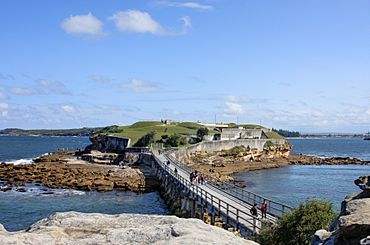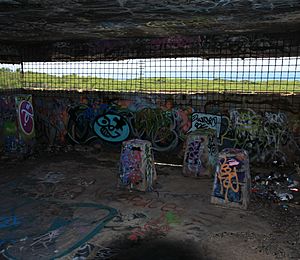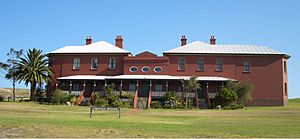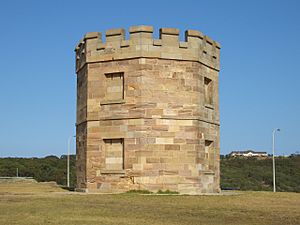La Perouse, New South Wales facts for kids
Quick facts for kids La PerouseSydney, New South Wales |
|||||||||||||||
|---|---|---|---|---|---|---|---|---|---|---|---|---|---|---|---|

Bare Island Fort, Botany Bay
|
|||||||||||||||
| Population | 399 (2016 census) | ||||||||||||||
| Postcode(s) | 2036 | ||||||||||||||
| Elevation | 12 m (39 ft) | ||||||||||||||
| Location | 14 km (9 mi) south-east of Sydney CBD | ||||||||||||||
| LGA(s) | City of Randwick | ||||||||||||||
| State electorate(s) | Maroubra | ||||||||||||||
| Federal Division(s) | Kingsford Smith | ||||||||||||||
|
|||||||||||||||
La Perouse is a beautiful suburb in the Eastern Suburbs of Sydney, Australia. It's located about 14 kilometres southeast of the Sydney central business district (CBD). This area is part of the City of Randwick.
The La Perouse peninsula forms the northern tip of Botany Bay. It's famous for its old military fort on Bare Island. It's also home to the Kamay Botany Bay National Park. You can find safe swimming spots at Congwong Bay Beach, Little Congwong Beach, and Frenchmans Bay. La Perouse is one of the few Sydney suburbs with a French name. Across Botany Bay, you'll find Kurnell.
Contents
History of La Perouse
La Perouse is named after a French explorer, Jean-François de Galaup, comte de Lapérouse. He landed here on January 26, 1788. This was just a few days after Captain Arthur Phillip and the First Fleet arrived in Botany Bay.
Lapérouse's Voyage to Australia
Louis XVI of France asked Lapérouse to explore the Pacific Ocean. This was inspired by Captain James Cook's earlier voyages. Cook had sailed along Australia's east coast in 1770. Lapérouse left France in 1785 with two ships: Astrolabe and Boussole. His journey was for scientific discovery.
Lapérouse's ships reached New South Wales after a difficult stop in Samoa. There, 12 of his men were attacked and killed. The Astrolabe and Boussole arrived in Botany Bay on January 24, 1788. This was only six days after Captain Arthur Phillip had anchored nearby.
Meeting the British Fleet
On January 26, 1788, Captain John Hunter was moving the British First Fleet. They were leaving Botany Bay for Port Jackson, which was a better place for a settlement. At the same time, Lapérouse was sailing into Botany Bay. He anchored there just eight days after the British.
The British welcomed Lapérouse and offered help. The French ships were well-supplied. They also offered help to the British. Neither offer was accepted. Captain Phillip sent two British naval ships, HMS Sirius and Supply, to meet the French. The French did not plan to claim Australia for France. Their meeting was friendly and followed normal rules. Lapérouse later sent his journals and letters to Europe with the British ship, the Sirius.
The First Burials
The expedition's naturalist and chaplain, Father Louis Receveur, died in February. He had been injured in a fight in Samoa. Receveur was buried at Frenchmans Cove in Botany Bay. This spot is now near the Lapérouse Museum. The local Aboriginal people removed the first marker. The British replaced it and looked after the site.
In 1825, a tombstone was placed there. It was designed by George Cookney. Receveur was the second European buried in Australia. The first was Forby Sutherland from Cook's 1770 expedition. He is buried at nearby Kurnell.
The French Disappear
The French stayed in Botany Bay for six weeks. They built a stockade, an observatory, and a garden. They also built a new longboat. After getting wood and water, they left for other islands. Lapérouse expected to be back in France by December 1788. However, his two ships vanished.
The last time anyone saw the French expedition was in March 1788. British lookouts at South Head saw them sail from Botany Bay. The ships were later wrecked on the reefs of Vanikoro in the Solomon Islands. This happened during a cyclone in April or May 1788. The mystery of their disappearance lasted for 40 years.
In 1826, items from the French ships were found. The shipwrecks themselves were discovered in 1964. More recently, two big expeditions explored the sites in Vanikoro. In 2005, one wreck was officially identified as the Boussole. French naval vessels helped with these scientific missions.
Historic Buildings and Forts


The first building in the area was an octagonal stone tower. It was built in 1820–22. Soldiers lived there to stop smuggling. This tower still stands today.
By 1885, an Aboriginal reserve was set up in the suburb. Several missions also operated there. The original church was moved to Elaroo and Adina Avenues. It is now known as the La Perouse Mission Church.
A kiosk was built in 1896 for tourists. They came to see attractions like snake-handling shows. During the Great Depression (late 1920s), many low-income families moved here. They lived in settlements near the Aboriginal reserve.
Bare Island Fort
Bare Island is a small island just inside the bay's entrance. Captain James Cook called it "a small bare island." It was fortified in 1885. This fort was designed by architect James Barnet. It was armed with heavy guns. From 1912 to 1963, Bare Island was a retirement home for war veterans. Today, it's a museum and tourist spot.
Other Fortifications
Two other forts are in La Perouse. One is Fort Banks on Cape Banks. It was built to protect Botany Bay from sea attacks during World War II. Henry Head Battery was built between 1892 and 1895. It was used until 1910. This battery, with its gun-emplacements and observation posts, was used again during World War II.
Heritage-Listed Sites
La Perouse has several places listed for their historical importance:
- Bare Island Fort
- 46 Adina Avenue: La Perouse Mission Church
- 1-39 Bunnerong Road: Chinese Market Gardens (La Perouse)
Transport in La Perouse
Trams
La Perouse used to have a tram line. It started in Darlinghurst and ran south along Anzac Parade. It went through Maroubra Junction and Malabar. The tram line ended in a circular track called "The Loop" at La Perouse. The line reached La Perouse in stages from 1900 to 1902. The tram service to La Perouse stopped in 1961. Today, the Transdev John Holland bus route 394X follows a similar path.
Ferries
New wharves are being built at La Perouse and Kurnell. These will allow a ferry service to run between the two places.
People of La Perouse
According to the 2016 census, 399 people lived in La Perouse.
- About 37.4% of the population were Aboriginal and Torres Strait Islander people.
- Most people (76.4%) were born in Australia.
- Most people (78.6%) spoke only English at home.
- The most common religion was No Religion (30.7%).
Things to See and Do
The Lapérouse Museum has maps, scientific tools, and items from French explorers. A walking trail from the museum leads to the Endeavour Lighthouse. From there, you can see Captain Cook's Landing Place across the bay. The large Lapérouse Monument is an obelisk built by the French in 1825. Another memorial marks Father Receveur's grave.
Bare Island is connected by a footbridge. The museum building was first a cable station. It housed the first underwater telegraph cable between Australia and Nelson, New Zealand. This cable was the first link for New Zealand to the rest of the world. Later, the building was a home for orphans.
Aboriginal Culture and Shows
Visitors can learn about the area's Indigenous history. Aboriginal people often give boomerang-throwing demonstrations on weekends. Aboriginal guided tours also run from Yarra Bay House during the week. Local people make and sell Aboriginal artefacts.
The Snake Man of La Perouse has an outdoor reptile show. You can see it in the pit at The Loop on Sunday afternoons. These shows started in the late 1800s with Professor Fox. George Cann continued them after World War I. The Cann family and other snake handlers have kept the tradition going.
Food and Golf
La Perouse has a few cafés and restaurants. They are located around the historic area, near Frenchmans Bay. The New South Wales Golf Club is also in La Perouse. It's a links-style golf course with views of both Botany Bay and the Tasman Sea.
Scuba Diving Adventures
The waters around the La Perouse peninsula are great for scuba diving in New South Wales. Bare Island has several dive spots, some over 19 metres deep. The reef here is very large. There are also many dive sites around the mainland at La Perouse. Divers can see amazing creatures like the common (weedy) sea dragon, pygmy pipefish, and big-belly seahorses. You'll also spot other fish common in Sydney.
La Perouse in Movies
- Parts of the movie Mission: Impossible II (2000) were filmed in La Perouse. This included scenes at Bare Island.
Famous People from La Perouse
- Kevin Longbottom (1940−1986), a rugby league player
- Lola Ryan (1925−2003), a shellworker
- Emma Timbery (c. 1842−1916), an Aboriginal shellworker and important community leader
- Esme Timbery (1931–2023), a shellworker




